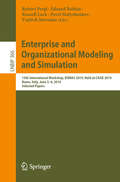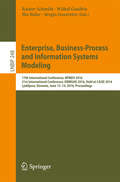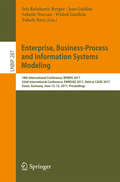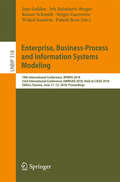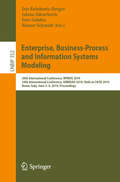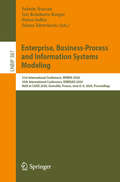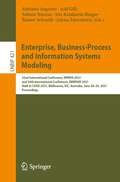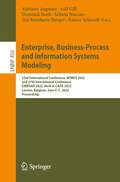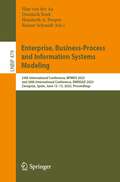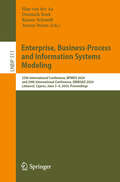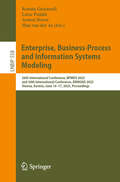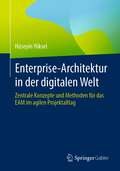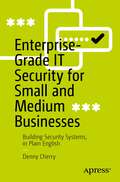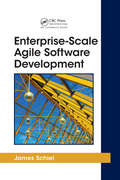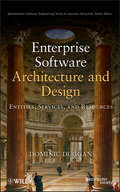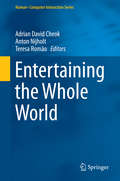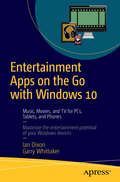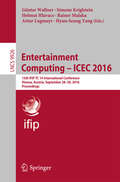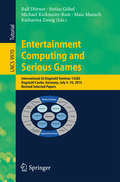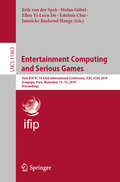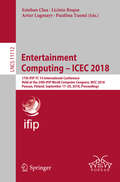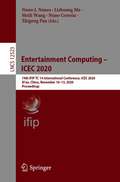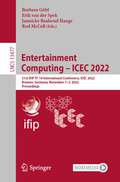- Table View
- List View
Enterprise and Organizational Modeling and Simulation: 15th International Workshop, EOMAS 2019, Held at CAiSE 2019, Rome, Italy, June 3–4, 2019, Selected Papers (Lecture Notes in Business Information Processing #366)
by Eduard Babkin Robert Pergl Russell Lock Pavel Malyzhenkov Vojtěch MerunkaThis book constitutes the refereed proceedings of the 15th International Workshop on Enterprise and Organizational Modeling and Simulation, EOMAS 2019, held in Rome, Italy, in June 2019. The main focus of EOMAS is on the role, importance, and application of modeling and simulation within the extended organizational and enterprise context. The 12 full papers presented in this volume were carefully reviewed and selected from 25 submissions. They were organized in topical sections on conceptual modeling, enterprise engineering, and formal methods.
Enterprise, Business-Process and Information Systems Modeling
by Rainer Schmidt Wided Guédria Ilia Bider Sérgio GuerreiroThis book contains the refereed proceedings of the 17th International Conference on Business Process Modeling, Development and Support, BPMDS 2016, and the 21st International Conference on Exploring Modeling Methods for Systems Analysis and Design, EMMSAD 2016, held together with the 28th International Conference on Advanced Information Systems Engineering (CAiSE 2016) in Ljubljana, Slovenia, in June 2016. The focus theme for BPMDS 2016 papers was "Business Processes in a Connected World", for which three subthemes were identified: business processes for connecting people, connecting intelligent objects to business processes and connecting information/data/knowledge to business processes. The 17 full and 1 short paper accepted for BPMDS were selected from 48 submissions and are grouped into topical sections on process execution support; improving usability of process models; social and human perspectives; new directions in process modeling; consistency, correctness and compliance; process and data mining; and process variability. The intention of EMMSAD is to solicit papers related to the field of information systems analysis and design including numerous information modeling methods and notations that are typically evolving. These ongoing changes significantly impact the way information systems, enterprises, and business processes are being analyzed and designed in practice. The 12 full papers accepted for EMMSAD were chosen from 19 submissions and are grouped into topical sections on fundamental issues in modeling; requirements and regulations; enterprise and software ecosystem modeling; information and process model quality; meta-modeling and domain specific modeling and model composition; and modeling of architecture and design.
Enterprise, Business-Process and Information Systems Modeling: 18th International Conference, BPMDS 2017, 22nd International Conference, EMMSAD 2017, Held at CAiSE 2017, Essen, Germany, June 12-13, 2017, Proceedings (Lecture Notes in Business Information Processing #287)
by Iris Reinhartz-Berger, Jens Gulden, Selmin Nurcan, Wided Guédria and Palash BeraThis book constitutes the proceedings of two events held in conjunction with the CAiSE conferences and related to the areas of enterprise, business-process and information systems modeling: the 18th International Conference on Business Process Modeling, Development and Support, BPMDS 2017, and the 22nd International Conference on Evaluation and Modeling Methods for Systems Analysis and Development, EMMSAD, 2017. They took place in Essen, Germany, in June 2017. The focus theme for BPMDS 2017 papers was “Enabling Business Transformation by Business Process Modeling, Development and Support". From 24 submitted papers, 11 were finally accepted and organized by: Non-functional considerations in business processes; new challenges in business process modeling and support; testing business processes; business process model comprehension; an experience report on teaching business process modeling. The EMMSAD conference focuses on evaluating, exploring and enhancing modeling methods and techniques for the development of information and software systems, enterprises, and business processes. It received 25 submissions, from which 9 full and 2 short papers were selected and organized: evaluation and comparison of modeling languages and methods; modeling approaches to support decision making; behavioral specification and business process modeling; and modeling languages and methods in evolving context.
Enterprise, Business-Process and Information Systems Modeling: 19th International Conference, BPMDS 2018, 23rd International Conference, EMMSAD 2018, Held at CAiSE 2018, Tallinn, Estonia, June 11-12, 2018, Proceedings (Lecture Notes in Business Information Processing #318)
by Iris Reinhartz-Berger Rainer Schmidt Wided Guédria Sérgio Guerreiro Jens Gulden Palash BeraThis book constitutes the proceedings of two events held at the CAiSE conference and relating to the areas of enterprise, business process and information systems modeling: The 19th International Conference on Business Process Modeling, Development and Support, BPMDS 2018, and the 23rd International Conference on Evaluation and Modeling Methods for Systems Analysis and Development, EMMSAD 2018. The conferences took place in Tallinn, Estonia, in June 2018. The 13 papers accepted for BPMDS were carefully reviewed and selected from 29 submissions; for EMMSAD 6 papers out of 13 submissions were accepted for publication. For BPMDS 2018, the papers were organized in topical sections as follows: context-awareness in business processes; automatic analysis of business processes; advanced approaches for business process modeling; evaluation of business process modeling techniques; an experience report on modeling collaborative processes. For EMMSAD 2018, the six related papers are listed without further sections.
Enterprise, Business-Process and Information Systems Modeling: 20th International Conference, BPMDS 2019, 24th International Conference, EMMSAD 2019, Held at CAiSE 2019, Rome, Italy, June 3–4, 2019, Proceedings (Lecture Notes in Business Information Processing #352)
by Iris Reinhartz-Berger Rainer Schmidt Jens Gulden Jelena ZdravkovicThis book constitutes the proceedings of two events held at the CAiSE conference and relating to the areas of enterprise, business process and information systems modeling: The 20th International Conference on Business Process Modeling, Development and Support, BPMDS 2019, and the 24th International Conference on Evaluation and Modeling Methods for Systems Analysis and Development, EMMSAD 2019. The conferences took place in Rome, Italy, in June 2019. The 7 full and 2 short papers accepted for BPMDS were carefully reviewed and selected from a total of 20 submissions; for EMMSAD 15 full papers were accepted from 38 submissions. The papers were organized in topical sections named as follows: BPMDS: large and complex business process modeling and development; execution and understandability of declarative process models; novel approaches in enterprise modeling; transformative business process modeling, development, and support. EMMSAD: foundations of modeling and method engineering; enterprise process and capability modeling; information systems and requirements modeling; domain-specific and ontology modeling; and evaluation of modeling approaches.
Enterprise, Business-Process and Information Systems Modeling: 21st International Conference, BPMDS 2020, 25th International Conference, EMMSAD 2020, Held at CAiSE 2020, Grenoble, France, June 8–9, 2020, Proceedings (Lecture Notes in Business Information Processing #387)
by Selmin Nurcan Iris Reinhartz-Berger Pnina Soffer Jelena ZdravkovicThis book contains the proceedings of two long-running events held along with the CAiSE conference relating to the areas of enterprise, business-process and information systems modeling: * the 21st International Conference on Business Process Modeling, Development and Support, BPMDS 2020, and * the 25th International Conference on Exploring Modeling Methods for Systems Analysis and Development, EMMSAD 2020. The conferences were planned to take place in Grenoble, France, during June 8–9, 2020. They were held virtually due to the COVID-19 pandemic. For BPMDS 13 full papers and 1 short paper were carefully reviewed and selected for publication from a total of 30 submissions; for EMMSAD 11 full papers and 4 short papers were accepted from 29 submissions. The papers were organized in topical sections named as follows: BPMDS: Business process execution and monitoring, BPM applications in industry and practice, planning and scheduling in business processes, process mining, process models and visualizations EMMSAD: Requirements and method engineering, enterprise and business modeling, software-related modeling, domain-specific modeling, evaluation-related research.
Enterprise, Business-Process and Information Systems Modeling: 22nd International Conference, BPMDS 2021, and 26th International Conference, EMMSAD 2021, Held at CAiSE 2021, Melbourne, VIC, Australia, June 28–29, 2021, Proceedings (Lecture Notes in Business Information Processing #421)
by Selmin Nurcan Iris Reinhartz-Berger Rainer Schmidt Jelena Zdravkovic Adriano Augusto Asif GillThis book contains the proceedings of two long-running events held along with the CAiSE conference relating to the areas of enterprise, business-process and information systems modeling: * the 22nd International Conference on Business Process Modeling, Development and Support, BPMDS 2021, and * the 26th International Conference on Exploring Modeling Methods for Systems Analysis and Development, EMMSAD 2021. The conferences were planned to take place in Melbourne, Australia, during June 28–29, 2021, but changed to an online format due to the COVID-19 pandemic. For BPMDS 10 full papers and 1 short paper were carefully reviewed and selected for publication from a total of 26 submissions; for EMMSAD 13 full papers and 1 short paper were accepted from 34 submissions. The papers were organized in topical sections as follows: BPMDS: Improving event data quality in coherence with business requirements; enhancing the value of data in processes improvement; event stream and predictive monitoring; modeling languages and reference models; EMMSAD: Enterprise modeling; handling models and modeling methods; threat and evidence modeling; and model-driven engineering and applications.
Enterprise, Business-Process and Information Systems Modeling: 23rd International Conference, BPMDS 2022 and 27th International Conference, EMMSAD 2022, Held at CAiSE 2022, Leuven, Belgium, June 6–7, 2022, Proceedings (Lecture Notes in Business Information Processing #450)
by Selmin Nurcan Iris Reinhartz-Berger Rainer Schmidt Dominik Bork Adriano Augusto Asif GillThis book contains the refereed proceedings of two long-running events held along with the CAiSE conference relating to the areas of enterprise, business-process and information systems modeling: * the 23rd International Conference on Business Process Modeling, Development and Support, BPMDS 2022, and * the 27th International Conference on Exploring Modeling Methods for Systems Analysis and Development, EMMSAD 2022. The conferences were taking place in Leuven, Belgium during June 6-7, 2022. For BPMDS 7 full papers and 2 short papers were carefully reviewed and selected for publication from a total of 18 submissions; for EMMSAD 11 full papers and 3 short papers were accepted from 30 submissions after thorough reviews. The papers were organized in topical sections as follows: BPMDS: Actual and perceived challenges; business process modeling; understanding collaboration: one issue, many perspectives; and event logs – why it derivates; EMMSAD: Foundations of modeling and method engineering; enterprise, business process, and capability modeling; information systems and requirements modeling; domain-specific and knowledge modeling; and evaluation of modeling approaches.
Enterprise, Business-Process and Information Systems Modeling: 24th International Conference, BPMDS 2023, and 28th International Conference, EMMSAD 2023, Zaragoza, Spain, June 12–13, 2023, Proceedings (Lecture Notes in Business Information Processing #479)
by Rainer Schmidt Han van der Aa Henderik A. Proper Dominik BorkThis book contains the refereed proceedings of two long-running events held along with the CAiSE conference relating to the areas of enterprise, business-process and information systems modeling: * the 24th International Conference on Business Process Modeling, Development and Support, BPMDS 2023, and * the 28th International Conference on Exploring Modeling Methods for Systems Analysis and Development, EMMSAD 2023. The conferences were taking place in Zaragoza, Spain, during June 12-13, 2023. For BPMDS 9 full papers and 2 short papers were carefully reviewed and selected for publication from a total of 26 submissions; for EMMSAD 9 full papers and 3 short papers were accepted from 26 submissions after thorough reviews. The BPMDS papers deal with a broad range of theoretical and applications-based research in business process modeling, development and support. EMMSAD focusses on modeling methods for systems analysis and development.
Enterprise, Business-Process and Information Systems Modeling: 25th International Conference, BPMDS 2024, and 29th International Conference, EMMSAD 2024, Limassol, Cyprus, June 3–4, 2024, Proceedings (Lecture Notes in Business Information Processing #511)
by Arnon Sturm Rainer Schmidt Han van der Aa Dominik BorkThis book contains the refereed proceedings of two long-running events held along with the CAiSE conference relating to the areas of enterprise, business-process and information systems modeling: - the 25th International Conference on Business Process Modeling, Development and Support, BPMDS 2024, and - the 29th International Conference on Exploring Modeling Methods for Systems Analysis and Development, EMMSAD 2024. The conferences were taking place in Limassor, Cyprus, during June 3–4, 2024. For BPMDS 8 full papers and 3 short papers were carefully reviewed and selected for publication from a total of 25 submissions; for EMMSAD 11 full papers and 5 short papers were accepted from a total of 32 submissions after thorough reviews. The BPMDS papers deal with a broad range of theoretical and applications-based research in business process modeling, development and support. EMMSAD focusses on modeling methods for systems analysis and development.
Enterprise, Business-Process and Information Systems Modeling: 26th International Conference, BPMDS 2025, and 30th International Conference, EMMSAD 2025, Vienna, Austria, June 16–17, 2025, Proceedings (Lecture Notes in Business Information Processing #558)
by Arnon Sturm Han van der Aa Renata Guizzardi Luise PufahlThis book constitutes the refereed proceedings of two long-running events held along with the CAiSE conference and related to the areas of enterprise, business-process and information systems modeling: - the 26th International Conference on Business Process Modeling, Development and Support, BPMDS 2025 and - the 30th International Conference on Exploring Modeling Methods for Systems Analysis and Development, EMMSAD 2025. The conferences were taking place in Vienna, Austria, during June 16–17, 2025. For BPMDS 12 full papers were carefully reviewed and selected for publication from a total of 39 submissions. The BPMDS papers deal with a broad range of theoretical and applications-based research in business process modeling, development and support. For EMMSAD 13 full papers and 3 short papers were accepted from a total of 37 submissions after thorough reviews. EMMSAD focusses on modeling methods for systems analysis and development.
Enterprise-Architektur in der digitalen Welt: Zentrale Konzepte und Methoden für das EAM im agilen Projektalltag
by Hüseyin YükselWie schaffen Unternehmen die Transformation in die agile, innovative, digitale Geschäfts- und Arbeitswelt? Diese Frage treibt nicht nur IT-Manager, sondern auch die strategischen Akteure, die Enterprise-Architekten, um. Sie müssen den Spagat zwischen strategischer Planung und dem Umgang mit steigender Geschwindigkeit und wachsender Unsicherheit leisten. Eine ganzheitliche Unternehmensentwicklung in der digitalen Zukunft heißt, digitale Ökosysteme und komplexe IT-Landschaften zu entwickeln. In diesem Buch werden Methoden und Konzepte aus der agilen Welt, der Zeichentheorie und der Neuropsychologie vorgestellt, die dem Enterprise-Architekten im praktischen Alltag helfen können. Ausgehend von einem positiven Menschenbild kann es mit dem grundlegenden Wissen gelingen, das Potential von Individuen und Teams für den digitalen Wandel auszuschöpfen. Das Buch richtet sich vorwiegend an IT-Manager, Enterprise-Architekten und Manager im Umfeld von größeren Softwareentwicklungsprozessen.Viele praxisnahe Beispiele veranschaulichen die theoretisch dargestellten Zusammenhänge und eröffnen einen breiteren Zugang zum Enterprise-Architektur-Management.
Enterprise-Grade IT Security for Small and Medium Businesses: Building Security Systems, in Plain English
by Denny CherryUnderstand the IT security features that are needed to secure the IT infrastructure of a small to medium-size business. This book will give IT managers and executives a solid understanding of the different technology solutions that their business relies upon–or should be employing–in order to make reasoned decisions regarding the implementation of those features. Coverage includes multi-factor authentication, firewalls, zero-trust environments, network segmentation, remote access solutions, and the people aspects of security that are often overlooked and represent an organization’s biggest vulnerability. Chapters on the various technologies such as multi-factor authentication and zero-trust environments explain in plain English the values and benefits that each technology provides. Clear technical explanations are accompanied by business case explanations that explain the “why” of each technology and when each technology should be implemented. You will come away equipped to have business-driven discussions with your IT staff that allow for a productive balancing of the need for security with the need to do business and drive profits. You Will LearnThe importance of multi-factor authenticationThe limits of what multi-factor authentication can protectHow firewalls are used to protect your company from attackersWhat zero-trust environments are and what they meanWhether zero-trust networks are what is needed to secure your own environmentThe security benefits from implementing a network segmentation policyThe best ways to access files and resources from remote locations outside the officeWho This Book Is ForManagers and executives at small to medium-size businesses who want to understand the core aspects of IT security on which their business relies, business leaders who want to be able to follow along with and engage in discussions with IT professionals about security features, and leaders who are tasked with making decisions on which IT security features to implement
Enterprise-Scale Agile Software Development (Applied Software Engineering Series)
by James SchielEnterprise-Scale Agile Software Development is the collective sum of knowledge accumulated during the full-scale transition of a 1400-person organization to agile development-considered the largest implementation of agile development and Scrum ever attempted anywhere in the world. Now James Schiel, a certified Scrum trainer and member of the Scrum
Enterprises software architecture and design
by Dominic DugganThis book fills a gap between high-level overview texts that are often too general and low-level detail oriented technical handbooks that lose sight the "big picture". This book discusses SOA from the low-level perspective of middleware, various XML-based technologies, and basic service design. It also examines broader implications of SOA, particularly where it intersects with business process management and process modeling. Concrete overviews will be provided of the methodologies in those fields, so that students will have a hands-on grasp of how they may be used in the context of SOA.
Entertaining the Whole World
by Anton Nijholt Adrian David Cheok Teresa Romão'Entertainment media' are entertainment products and services that rely on digital technology and include traditional media (such as movies, TV, computer animation etc) as well as emerging services for wireless and broadband, electronic toys, video games, edutainment, and location-based entertainment (from PC game rooms to theme parks). Whilst most of the digital entertainment industry is found in the developed countries such as USA, Europe, and Japan, the decreasing costs of computer and programming technologies enables developing countries to really benefit from entertainment media in two ways: as creators and producers of games and entertainment for the global market and as a way to increase creativity and learning among the youth of the developing world. Focusing specifically on initiatives that use entertainment technologies to promote economic development, education, creativity and cultural dissemination, this book explores how current technology and the use of off-the-shelf technologies (such as cheap sensors, Kinect, Arduino and others) can be exploited to achieve more innovative and affordable ways to harness the entertainment power of creating. It poses questions such as 'How can we convert consumers of entertainment into creators of entertainment?' 'How can digital entertainment make a contribution to the emerging world?'. Academic researchers and students in human-computer interaction, entertainment computing, learning technologies will find the content thought-provoking, and companies and professionals in game and entertainment technology, mobile applications, social networking etc. will find this a valuable resource in developing new products and new markets.
Entertainment Apps on the Go with Windows 10
by Ian Dixon Garry WhittakerThis book enables you to unleash the entertainment potential of your Windows 10 PC, tablet, or phone--or any combination of the three! Learn how to stream movies and TV shows, manage your media collection, purchase new media, and upload your music collection to the cloud. Make your entertainment experience truly mobile by streaming wirelessly between devices in the home, or from cloud services that let you take your content anywhere. Learn to push content from Windows 10 to other devices like TVs, or your Xbox One. Tap into a wide range of popular streaming services, including Netflix, Spotify, and Google Play. Ian Dixon and Garry Whittaker take the hassle out of managing and enjoying music, TV, and movies from your own collection and beyond. Whether you already have an extensive music and video collection, or are just getting started, this book will help you get the best entertainment from Windows. What you'll learn Use music streaming services on a phone, tablet or laptop Stream from thousands of radio stations to your Windows 10 phone or PC Purchase and manage music and video collections Use iTunes with Windows 10 tablets, laptops and phones Find out what type of media files work with Windows 10 Enjoy your existing music collection on Windows 10 PCs, phones and tablets Stream movies and TV shows from Netflix, and stream music to Windows, Android, and iOS devices Use Windows 10's Data Sense app to monitor your phone and PC data usage Use Windows 10 to wirelessly access media stored on Windows 7, Windows 8. 1 and Windows 10 PCs around the home Use PlayTo to send content to Network Attached (NAS) devices in your home, including Xbox One, TVs and media players Get started building your personal media cloud so you can access your music and videos from anywhere in the world and on any device Who this book is for The book is for home users that are either new to Windows or upgrading from previous versions of the operating system and want to enjoy music, movies and TV shows on their phone, tablet, or laptop. Table of Contents Chapter 1: Music Services On the Go Chapter 2: Storing Your Music in the Cloud Chapter 3: Watching Videos, Movies, and TV Shows Chapter 4: Streaming Your Media Collection from Windows Devices Chapter 5: Streaming Media Around the Home Chapter 6: Setting Up Media Servers to Stream Your Content
Entertainment Computing - ICEC 2016
by Artur Lugmayr Rainer Malaka Günter Wallner Simone Kriglstein Helmut Hlavacs Hyun-Seung YangThis book constitutes the refereed proceedings of the 15th InternationalConference on Entertainment Computing, ICEC 2016, held in Vienna, Austria, in September 2016. The 16 full papers, 13 short papers, and 2 posters presented were carefully reviewed and selected from 46 submissions. The multidisciplinary nature of entertainment computing is reflected by the papers. They are organized in the following topical sections: games for health, learning, and social change; use and evaluation of digital entertainment; and entertainment technology.
Entertainment Computing and Serious Games
by Michael Kickmeier-Rust Katharina Zweig Ralf Dörner Stefan Göbel Maic MasuchThe aim of this book is to collect and to cluster research areas in the field of serious games and entertainment computing. It provides an introduction and gives guidance for the next generation of researchers in this field. The 18 papers presented in this volume, together with an introduction, are the outcome of a GI-Dagstuhl seminar which was held at Schlo#65533; Dagstuhl in July 2015.
Entertainment Computing and Serious Games: First IFIP TC 14 Joint International Conference, ICEC-JCSG 2019, Arequipa, Peru, November 11–15, 2019, Proceedings (Lecture Notes in Computer Science #11863)
by Stefan Göbel Jannicke Baalsrud Hauge Esteban Clua Erik van der Spek Ellen Yi-Luen DoThis book constitutes the refereed proceedings of the First IFIP TC 14 Joint International Conference on Entertainment Computing and Serious Games, ICEC-JCSG 2019, held in Arequipa, Peru, in November 2019.The 26 full papers, 5 short papers, and 16 poster, demonstration, and workshop papers presented were carefully reviewed and selected from 88 submissions. They cover a large range of topics at the multidisciplinary intersection of design, art, entertainment, interaction, computing, psychology, and numerous serious application domains. The papers are organized in the following topical sections: mixed reality; virtual reality; entertainment algorithms; game design and development; interaction technologies; measurement and effects; and serious game applications.
Entertainment Computing – ICEC 2017: 16th Ifip Tc 14 International Conference, Tsukuba City, Japan, September 18-21, 2017, Proceedings (Lecture Notes in Computer Science #10507)
by Nagisa Munekata Itsuki Kunita Junichi HoshinoThis book constitutes the refereed proceedings of the 16th International Conference on Entertainment Computing, ICEC 2017, held in Tsukuba City, Japan, in September 2017. The 16 full papers, 13 short papers, and 2 posters presented were carefully reviewed and selected from 46 submissions.
Entertainment Computing – ICEC 2018: 17th IFIP TC 14 International Conference, Held at the 24th IFIP World Computer Congress, WCC 2018, Poznan, Poland, September 17–20, 2018, Proceedings (Lecture Notes in Computer Science #11112)
by Artur Lugmayr Esteban Clua Licinio Roque Pauliina TuomiThis book constitutes the refereed proceedings of the 17th International Conference on Entertainment Computing, ICEC 2018, held at the 24th IFIP World Computer Congress, WCC 2018, in Poznan, Poland, in September 2018.The 15 full papers, 13 short papers, and 23 poster, demostration, and workshop papers presented were carefully reviewed and selected from 65 submissions. They cover a large range of topics in the following thematic areas: digital games and interactive entertainment; design, human-computer interaction, and analysis of entertainment systems; interactive art, performance and cultural computing; entertainment devices, platforms and systems; theoratical foundations and ethical issues; entertainment for purpose and persuasion; computational methodologies for entertainment; and media studies, communication, business, and information systems.
Entertainment Computing – ICEC 2020: 19th IFIP TC 14 International Conference, ICEC 2020, Xi'an, China, November 10–13, 2020, Proceedings (Lecture Notes in Computer Science #12523)
by Zhigeng Pan Nuno J. Nunes Lizhuang Ma Meili Wang Nuno CorreiaThis book constitutes the refereed proceedings of the 19th IFIP TC 14 International Conference on Entertainment Computing, ICEC 2020, which was supposed to take place in Xi’an, China, in November 2020, but it was instead held virtually due to the COVID-19 pandemic.The 21 full papers and 18 short papers presented were carefully reviewed and selected from 72 submissions. They cover a large range of topics in the following thematic areas: games; virtual reality and augmented reality; artificial intelligence; edutainment and art; 3D modeling; and animation.
Entertainment Computing – ICEC 2021: 20th IFIP TC 14 International Conference, ICEC 2021, Coimbra, Portugal, November 2–5, 2021, Proceedings (Lecture Notes in Computer Science #13056)
by Jannicke Baalsrud Hauge Jorge C. S. Cardoso Licínio Roque Pedro A. Gonzalez-CaleroThis book constitutes the refereed proceedings of the 20th IFIP TC 14 International Conference on Entertainment Computing, ICEC 2021, which was supposed to take place in Coimbra, Portugal, in November 2021. The 26 full papers, 13 short papers and 11 other papers presented were carefully reviewed and selected from 84 submissions. ICEC brings together researchers and practitioners from diverse backgrounds to discuss the multidisciplinary intersection of design, art, entertainment, interaction, computing, psychology in the fields of gaming and entertainment computing.
Entertainment Computing – ICEC 2022: 21st IFIP TC 14 International Conference, ICEC 2022, Bremen, Germany, November 1–3, 2022, Proceedings (Lecture Notes in Computer Science #13477)
by Jannicke Baalsrud Hauge Erik van der Spek Barbara Göbl Rod McCallThis book constitutes the refereed proceedings of the 21sth IFIP TC 14 International Conference on Entertainment Computing, ICEC 2022, which was supposed to take place in Bremen, Germany, in November 2022.The 13 full papers, 13 short papers and 12 other papers presented were carefully reviewed and selected from 72 submissions. ICEC brings together researchers and practitioners from diverse backgrounds to discuss the multidisciplinary intersection of design, art, entertainment, interaction, computing, psychology in the fields of gaming and entertainment computing.
